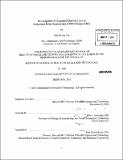Investigation of acquired hearing loss in dopamine beta hydroxylase (DBH)-mutant mice
Author(s)
Lee, Suh-Kyung
DownloadFull printable version (3.214Mb)
Other Contributors
Harvard University--MIT Division of Health Sciences and Technology.
Advisor
John J. Rosowski.
Terms of use
Metadata
Show full item recordAbstract
The influence of middle-ear disease on hearing in mice is not well understood. We investigated middle-ear function and structure in a small group of dopamine beta hydroxylase (DBH)- knockout mice, which are known to be susceptible to middle-ear disease. We measured auditory brainstem response (ABR) and distortion-product otoacoustic emission (DPOAE) thresholds, as well as sound-induced umbo velocity, and used standard histological techniques to study normal and pathological middle-ear anatomy. Anatomical analyses included observation of tympanic membrane and ossicular structures, reconstruction of middle ear volume, and estimation of the volume of lightly or darkly stained middle-ear fluid. Lightly stained fluid in diseased ears was located throughout the middle ear, whereas darkly stained fluid, when present, was usually seen near the round window. The ABR and DPOAE thresholds and the umbo velocity produced by lower- and middle-frequency sound stimuli were strongly correlated with middle-ear air volume. The volume of darkly stained fluid was correlated with the DPOAE and ABR thresholds for lower- and middle-frequency sounds. The volume of lightly stained fluid was correlated with the umbo velocity in the middle and upper frequencies. Regression analyses between the thresholds and velocity show the DPOAE threshold about twice the ABR threshold in the middle frequencies, while the ABR threshold was roughly inversely proportional to the umbo velocity at lower stimulus frequencies. The correlations between histological and functional results are consistent with a decrease in middle-ear air volume and the presence of lightly stained fluid affecting the motion of the TM, while the darkly stained fluid near the round window acts to reduce the middle ear vibrations that reach the cochlea. The inverse relationship between the ABR threshold and the umbo velocity is consistent with a conductive hearing loss produced by reduced middle-ear air volume.
Description
Thesis (S.M.)--Harvard-MIT Division of Health Sciences and Technology, 2011. Cataloged from PDF version of thesis. Includes bibliographical references (p. 25).
Date issued
2011Department
Harvard University--MIT Division of Health Sciences and TechnologyPublisher
Massachusetts Institute of Technology
Keywords
Harvard University--MIT Division of Health Sciences and Technology.